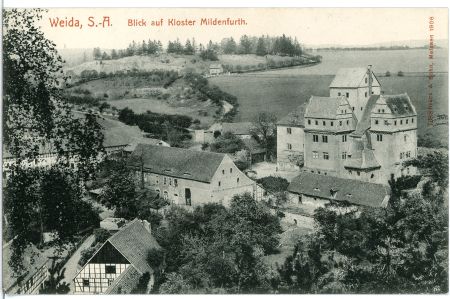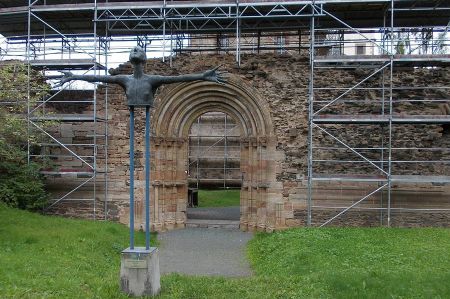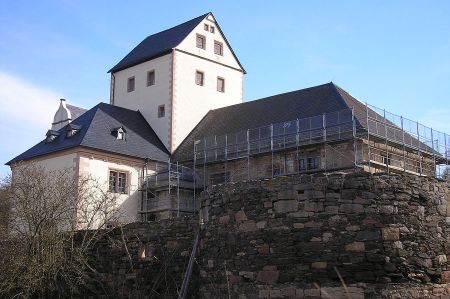Historic monastery Mildenfurth near Wünschendorf
- Written by Portal Editor
Only a few hundred meters from this year's meeting place for the bicycle caravan community at the Gasthof zum Klosterhof is the ancient Mildenfurth monastery, a former Premonstratensian monastery in the Mildenfurth district of Wünschendorf / Elster, which we also wanted to pay a short visit to for the purpose of the article.
We first walked to the imposing covered wooden bridge (we have already published an article on the wooden bridge), then always following the Weida river to the monastery. A lovely walk well worth pursuing.
Mildenfurth Monastery on the Weida
 The monastery was founded as a Premonstratensian provost in 1193 by the bailiff Heinrich II von Weida. The first canons came from the Liebfrauenstift in Magdeburg and later looked after eight parishes and a hospital. The Romanesque collegiate church was built around 1200, parts of which are still preserved today. It was a three-aisled basilica in a linked system with a stepped choir. To the south was the cloister. Parts of the south wing with the adjoining refectory have been preserved. Part of the site is still surrounded by a very high and well-fortified wall with loopholes and a Romanesque entrance gate.
The monastery was founded as a Premonstratensian provost in 1193 by the bailiff Heinrich II von Weida. The first canons came from the Liebfrauenstift in Magdeburg and later looked after eight parishes and a hospital. The Romanesque collegiate church was built around 1200, parts of which are still preserved today. It was a three-aisled basilica in a linked system with a stepped choir. To the south was the cloister. Parts of the south wing with the adjoining refectory have been preserved. Part of the site is still surrounded by a very high and well-fortified wall with loopholes and a Romanesque entrance gate.
The Mildenfurther Klostermühle was first mentioned in a document in 1260. A 1500 meter long mill ditch from the Krähenholz supplied the mill with water. The former water mill is outside the former monastery grounds. In 1313 the attempt to join the Cistercian order failed. Mildenfurth remained Premonstratensian and even joined the order reform in 1457 with 33 canons. Between 1436 and 1440, Sigismund of Saxony stayed in the convent, which made him feel closer to a nun he had fallen in love with.
Time of reformation and change
 In 1526 the Reformation was introduced in the country, which led to the abolition of the monastery by 1543. Ten Premonstratensians lived in the monastery under Provost Konrad Berger. In 1544 the site was sold to Matthes von Wallenrod, fortress captain of Coburg, who had it converted into a Renaissance palace in 1556. The transept, the main choir and parts of the nave were integrated into the palace building. The west tower was removed, only the ground floor with the former main portal remained. From 1617 the castle was acquired by Elector Johann Georg I. as a hunting lodge and later became a Saxon chamber estate, the Mildenfurth district was established. From 1816 to 1918 Mildenfurth, including the estate and castle, belonged to the Grand Duchy of Saxe-Weimar-Eisenach, in 1918 it was taken over by the state of Thuringia. Various uses followed from 1945 to 1988, such as a retirement home and fruit store.
In 1526 the Reformation was introduced in the country, which led to the abolition of the monastery by 1543. Ten Premonstratensians lived in the monastery under Provost Konrad Berger. In 1544 the site was sold to Matthes von Wallenrod, fortress captain of Coburg, who had it converted into a Renaissance palace in 1556. The transept, the main choir and parts of the nave were integrated into the palace building. The west tower was removed, only the ground floor with the former main portal remained. From 1617 the castle was acquired by Elector Johann Georg I. as a hunting lodge and later became a Saxon chamber estate, the Mildenfurth district was established. From 1816 to 1918 Mildenfurth, including the estate and castle, belonged to the Grand Duchy of Saxe-Weimar-Eisenach, in 1918 it was taken over by the state of Thuringia. Various uses followed from 1945 to 1988, such as a retirement home and fruit store.
Today it is used as an exhibition space
In 1995, the mill machines were still turning for the Köckritz agricultural cooperative for the production of compound feed. However, after modernization was completed, compound feed production was discontinued on October 30, 1999. The monastery has been used by the artist couple Volkmar Kühn and Marita Kühn-Leihbecher as an exhibition space since 1992 and as a gallery since 2007. The complex has belonged to the objects of the Thuringian Palaces and Gardens Foundation since 1995 and is being restored.
The working group art and culture "Mildenfurth Monastery" organizes concerts, theater performances and book readings in the old monastery walls. The small barrel vault regularly invites you to exhibitions of modern artists. Sculptures by Volkmar Kühn have found their permanent place in the monastery garden.
Please read as well:
2nd meeting of the fan community of bicycle caravan trailers
